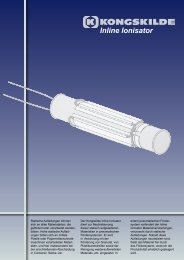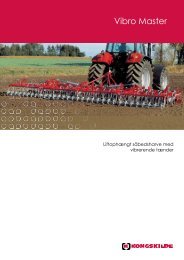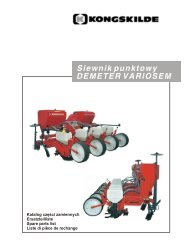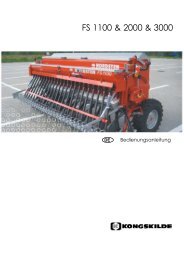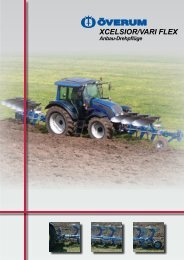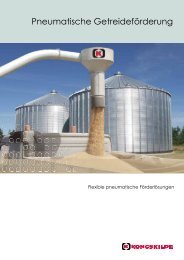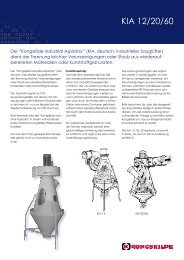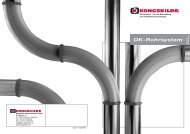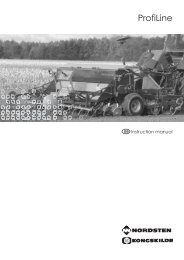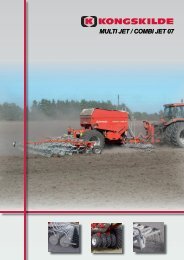Conveying Capacity - Kongskilde
Conveying Capacity - Kongskilde
Conveying Capacity - Kongskilde
You also want an ePaper? Increase the reach of your titles
YUMPU automatically turns print PDFs into web optimized ePapers that Google loves.
Principle of Operation<br />
10<br />
Intake nozzle<br />
Suction side<br />
The suction blower consists of a<br />
powerful blower and a rotary valve.<br />
<strong>Conveying</strong> is started by using the<br />
suction air of the blower to lift and<br />
accelerate the grain towards the<br />
blower.<br />
Blower Rotary valve<br />
Suction<br />
cyclone<br />
Just before the grain reaches the<br />
blower housing it is separated<br />
from this air stream in a cyclone<br />
and dropped into the rotary valve,<br />
whereas the air continues to the<br />
blower. The rotary valve conveys<br />
the grain from the suction side in<br />
the cyclone to the pressure side in<br />
the transport pipe.<br />
Function and Use of Air Regulator<br />
The blower is provided with an<br />
automatic air regulator positioned in<br />
the pipe between the cyclone and<br />
the blower intake.<br />
The purpose of the air regulator<br />
is to limit the max air speed of approx.<br />
25 m/sec. Thus grain damage<br />
owing to excessive speed as well<br />
as overloading of blower will be<br />
avoided.<br />
The air regulator is a spring-loaded<br />
butterfly valve. When the blower is<br />
stopped the air regulator is completely<br />
open. When the blower is<br />
started the air flow will close the<br />
regulator so that the air speed does<br />
not exceed approx. 25 m/sec.<br />
When the back pressure drops, the<br />
air regulator will close sufficiently<br />
to prevent the air speed exceeding<br />
approx. 25 m/sec. A typical<br />
example is the variations in back<br />
pressure which occur at clean-up<br />
operations.<br />
The air regulator will only be effective<br />
if the spring of the regulator is<br />
Pressure side<br />
Discharge cyclone<br />
Grain is carried to the outlet cyclone<br />
in air stream. In order to<br />
secure a balance between air and<br />
material, the suction blower is<br />
equipped with an adjustable intake<br />
nozzle.<br />
properly adjusted. Therefore, never<br />
adjust the spring unless the proper<br />
equipment is used to check that<br />
the ideal conveying speed is maintained.<br />
If the spring of the air regulator is<br />
too slack, max air speed will be<br />
reduced and thus conveying capacity<br />
will fall. At the same time there<br />
is the risk of material settling in the<br />
pipes and plugging could occur.<br />
If the spring is overtightened, the<br />
max air speed will be increased,<br />
increasing risk of damage to the<br />
product conveyed. <strong>Capacity</strong> will not<br />
be increased but blower and tractor<br />
will be under more load. Hence<br />
belts and bearing of the blower will<br />
be loaded in excess of what they<br />
are designed for. Consequently,<br />
their life will be considerably<br />
shortened.



